Car Audio Basics
Since the race to launch the first car radio started in the early 20th century, car audio hasn’t stopped evolving. Trying to understand it all means you have to keep learning, but getting a grasp of car audio basics is easily within grasp.
And anyone intending to update any part of their car stereo system, really should try and get a firm understanding of all the main parts. This will not only help you when deciding what to buy, but you’ll also be able to discern quality from, shall we call it lesser quality.
From powerful amplifiers to Double DIN multimedia players, and deep and crisp subwoofers to high-performance component speakers, we have never had such a plethora of choices to make up the best car audio systems. But all these choices make it difficult to choose the best car stereo equipment, especially if you’re not an audiophile who knows exactly what to look for.
As complicated as car audio is, and you need to be a math major to truly grasp it, you can get by understanding the car audio basics. And that’s what I look into here: outlining the basics of car audio, so even the newest noob has a decent understanding of it.
From head units and speakers, and other technical components such as subwoofers, amplifiers, and crossovers, I look into all the main parts so anyone new to car audio has a better understanding of the basics.
Check out my Car Audio Glossary blog for a deeper look at all car audio terminology.
Understanding Car Audio Basics
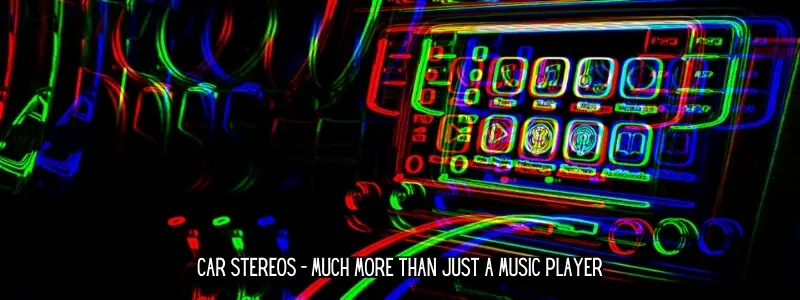
The Car Stereo / Head Unit
The composer of every car audio system is the car stereo. Often called the head unit, receiver, and of course the car radio, everybody knows what one is, even those with little grasp of car audio basics.
The main purpose of the head unit is to provide an audio signal to our other audio components. If you check out my other blog The History of The Car Stereo you will see how it has evolved from a simple radio receiver to a multimedia touchscreen, taking in all audio innovations along the decades.
Many believe the head unit isn’t that important, but nothing could be further from the truth. A cheap head unit will degrade sound quality because it has inferior sound processing capabilities and will affect the performance of your car stereo system.
This is because your head unit is what processes the frequencies and splits it into your channels. Yes, you can do it on an amplifier, but it’s easier if you have the full control on a head unit, especially if you have a good one with a good quality Equalizer (EQ).
Getting a car stereo with an EQs with more at least 3 bands offers greater control over your stereo’s sound, and will make a huge difference. Personally, I go for a head unit with no less than 5 bands, but it’s each to their own. Remember, the better your EQ is the easier it will be to sculpt the very sound ranges you want.
From Single DIN car stereos with high quality EQs to Double DIN touchscreen head units, the car stereo is critical no matter what features you need, and should be the start of your journey for understanding car audio basics.
As well as being the composer of your music, your head unit can be a SatNav, Rear Parking aid, a Movie Theater, while you can also surf the Internet, make hands free calls and text messages etcetera.
What to Consider When Getting A Car Stereo
The head unit is the brains of your car stereo system, so make sure you get one that can work properly with your other components, especially if you’re upgrading power hungry components, such as amplifiers and subwoofers.
For anyone who really wants to control a stereo soundscape, make sure you get a car stereo that has a good Equalizer EQ with at least 3 bands, which will ensure you have some exquisite high-fidelity, especially if you have some other aftermarket car audio equipment.
Another thing to consider when looking for a car stereo is whether it will fit. As already stated, there are two standard sizes: Single DIN and Double DIN.
A single DIN radio measures 2×7″ and are the classic size head units, while a double DIN measures 4×7″ and are quickly becoming the standard for newer models of cars.
Some single DIN car stereos do have LCD multimedia displays, like their double DIN cousins, but they’re a bit more limited due to size. Although some single DIN receivers have retractable displays, and offer much of what you can get with a double DIN head unit.
Whichever way you intend to replace and install a new car stereo, it’s not that difficult, even if you’re replacing a single DIN for a double DIN, so don’t be put off.
Car Amplifier
An amplifier is another key component to building the perfect soundscape for listening to music in your car, and if you aim to get a subwoofer, you have to get an amplifier.
In fact, all speakers need amplifiers, whether they’re in-built into your car radio or an external amplifier, to actually work.
Whereas a head unit provides an audio signal, an amplifier’s purpose is to increase that audio signal. Head units have built in amplifiers, but if you like your music loud and crisp, you have to get an amplifier for your car.
Amplifiers work by boosting an audio signal and sending it to your drivers. They do this by using electronic components such as capacitors and resistors to boost an inaudible line-level signal from your head unit, so it’s powerful enough to move a speaker’s cone back and forth to create sound.
There are amplifiers that are designed to run one driver, which is usually for the subwoofer. Or you can get multi-channel amplifiers to drive the amount of speakers you need.
For example, if you have a set of component speakers and a subwoofer, you’re better getting a 3-channel amplifier. If you have four speakers and a subwoofer, however, you should consider up to a 5-channel amplifier, because this will give you 1 channel for each driver.
You can bridge speakers and amplifier channels, however. For example, if you have a 4-channel amp and you have a subwoofer that needs more power, you could bridge 2 channels and drive your subwoofer with 2 channels and use the other two for running your speakers.
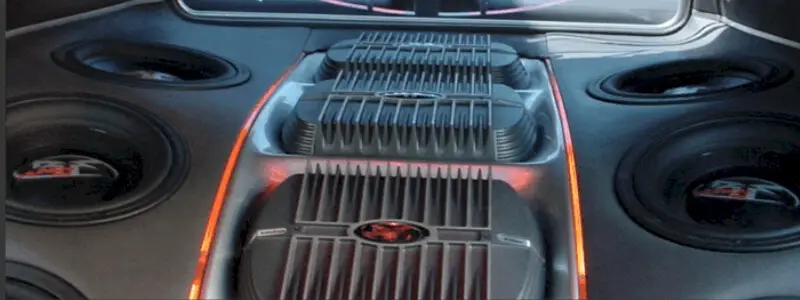
Things To Consider When Getting A Car Amplifier
When looking for a car amplifier, the main things to consider are the Class. Class D and Class A/B are the most popular amps, and depending on which type of amplifier you want will determine which Class you should get.
Class-D is mostly used for Subwoofer (Mono) Amplifiers for their efficiency, lower operating temperatures, and good bass reproduction. It’s not just mono amps that Class D is used in, however, because it’s quickly becoming more common in multi-channel amps, too.
Class-AB amps deliver a better midrange and treble reproduction and these are more expensive but you can run pretty much any system you like on them. However, multi-channel amps are known to use more power and are known to heat up more.
Although it’s more a concern for when you buy speakers, Impedance is another thing you should consider when buying an amp for your car. Measured in ohms (Ω), Impedance is basically the measurement of resistance that the speaker adds to the circuit.
In car audio, full-range mid-range speakers, and tweeters are usually rated at 4 Ω, whereas subwoofers are commonly 2 Ω. Most multi-channel amplifiers are configured for 4-8 Ω, so if you’re only running speakers from your amp, you will have more options.
If you’re running a subwoofer, however, you have to make sure your amplifier impedance matches the impedance of your system configuration, so if your subwoofer is 2Ωs, make sure to get an amp that can power that.
Depending on how you wire your speakers to your amplifier can offer more variations at a lower or higher impedance, if your amp can do so. Most can run at different levels of impedance, and if you want to know more about circuit wiring series check this article out.
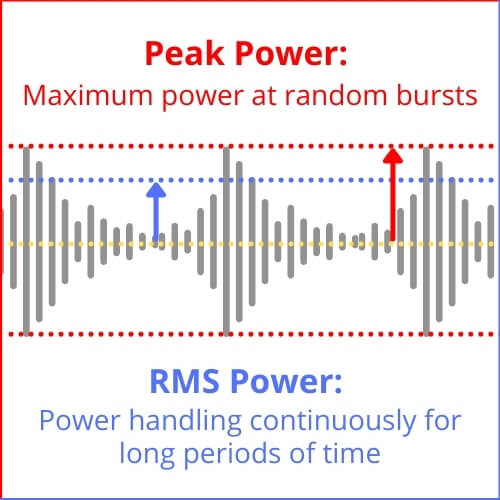
Power handling is another key factor to consider when looking for the best amplifier. This measured in (watts) RMS and only look for the continuous power handling, which is RMS. Peak power should be ignored when buying an amplifier for your car, as it’s a selling gimmick used by manufacturers to help sell their products.
RMS is basically the amount of continuous power that an amplifier can produce over an extended period of time. It’s measured in watts, and the higher the RMS rating, the louder and cleaner your music will sound.
When shopping for a car amp, make sure the RMS power on it matches that of your speakers and subwoofer. If you don’t match them your speakers could be underpowered, or even overpowered, which could potentially overheat and damage your audio system.
Car Speakers
Car speakers are more complex than you might think. Anyone that wants pristine fidelity in their car should know exactly what to look for in the speaker, but what suits one person might not suit the next.
To keep it simple, a speaker works by receiving an audio signal from the amplifier. This causes the woofer cone in the speaker system to move back and forth, and the vibration displaces air which creates the soundwaves.
There are two main types of speakers: Coaxial and Component Speakers. Coaxial speakers are the most common and they’re what you’ll find in most factory-installed car audio setups. They’re also the most popular aftermarket speakers, but this is more down to the ease of installation and relative price of coaxial speakers.
A coaxial speaker is an all-in-one speaker, which consists of a woofer that produces low- and mid-range sounds and a tweeter that protrudes from the woofer and produces the high range sound, and has an in-built crossover.
Component speakers are made up of several units (components). The woofer, tweeter and crossover are all separate, and have to be installed separately, making them more complex.
That said, the best component speakers produce much better sounds than the best coaxial speakers, thanks in part to the crossover network in the component speakers.
There’s a perennial coaxial vs component speakers debate, with each side offering a good argument. And while, most will agree component speakers are better, for most people coaxial speakers are good enough. So you have to decide whether the complexity of installation and extra price is worth it when going for component speakers.

Car speakers come in several different sizes, too. 6×9 inch, 6.5 inch, 6×8 inch, 5×7 inch, 8 inch, 5.25 inch are the most common speaker sizes, and they all serve a different purpose and offer differing soundscapes.
When you decide to upgrade your speakers, it’s a good idea to understand different speaker sizes because they’re not necessarily the size they say. Think of car speaker size more like the type of speaker.
Other Things To Consider When Buying Car Speakers
Aftermarket loudspeakers come with multi-drivers, the most common being 2-way and 3-way speakers. Although you can get 4 and 5-way speakers for your car, too.
2-way speakers are comprised of a woofer, which handles the low and mid-ranges, and a tweeter that handles the upper range of the mids and highs. They’re the most common speakers on the market.
3-way speakers have the same features as the 2-way plus they’ll have an additional speaker for the mid-range sounds. 3-way speakers is the agreed upon starting point for audiophiles who really like to sculpt a cleaner and more defined high fidelity.
4-way speakers are the same as 3-way speakers with the addition of extra drivers. Usually this is a super tweeter, but it really depends on the speaker set up. 5-way speakers could consist of a woofer, midwoofer, midrange, tweeter and super tweeter but other configurations are possible.
Don’t think because there are more drivers in your speaker that it will definitely sound better, even if you buy the very best. You can overcook a component, and super tweeters are difficult to handle at times.
If everything is working well, a super tweeter will enhance the soundscape no end. If you have to keep fiddling with them because of the music style, however, they can be more hassle than they’re worth.
For most people 2-way or 3-way speakers are enough, and as long as you get good quality brand, you will enhance the fidelity in your car no matter how many drivers you go for.
As with many things in car audio, you should consider the RMS, Impedance and the quality of the components that make up the speakers.
Tweeters
A tweeter or treble speaker is a special type of loudspeaker that’s designed to produce high audio frequencies, usually from 3k Hz to >20k Hz. They’re usually about 0.75” and 1” in size, because high ranges don’t need to push much air, so the driver only needs to be small compared with other drivers.
The high frequencies from a tweeter add an emotional dimension to your music, and a good quality set of tweeters will introduce you to instruments you have never heard before when listening to a song.
Dome tweeters and piezo tweeters are the most common types found in car speakers, and in coaxial speakers you’ll usually get a semi-dome tweeter. These offer slightly different treble sounds, which won’t be noticeable to most people, and they both produce excellent highs as long as you get a good quality speaker set.
In coaxial speakers tweeters are usually fixed protruding from the main woofer, whereas, component speakers are separate, and you can install these in a different location to the main driver.
This makes components speakers superior because installing them in a different location to your main speaker produces a noticeable improvement in sound quality.
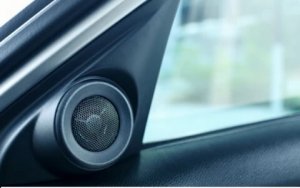
The best location for installing the tweeters is either in the dash, the upper part of the car door (away from the woofer), or the A Pillar.
The dash is where you’ll find your factory tweeters, but depending where you install them will determine the soundscape. Personally I prefer to install them in the A Pillar.
If you prefer to install them in your car door, it’s better to install them higher up from your main speaker, as it will give you better stereo imaging and add to the high-fidelity of your car audio stereo.
Subwoofers
Subwoofers are responsible for reproducing the lowest and deepest sound ranges that can vibrate the car seat you’re sitting in. They’re also usually the driver that can distort your music mostly if not configured properly, although many like that.
You can of course drive decent bass from speakers, but if you’re serious about producing the deepest lows with clarity, you really have to get a subwoofer.
To run a subwoofer takes a bit of knowledge and of course space, especially if you get a 15-inch, or even a 12-inch subwoofer. This is because they have to be installed in an enclosure and need an amplifier to run them.
Of course, the bigger the subwoofer, the bigger the enclosure, so you have to decide how much space you can give up before you buy one. If space is a premium, you can get smaller subwoofers that fit in snug spaces, but these won’t produce bass as loud as a bigger subwoofer.
8-inch subwoofers and 10” subs are also very popular for car owners, but as I say, you have to know how much space you can afford to give up and get a subwoofer and enclosure to match.
Some, subwoofers come with a built-in amplifier. These are known as Powered Subwoofers and they save on space because the amplifier is built into the subwoofer box. They’re also easier to install for obvious reasons, but many audiophiles don’t like them because the limitations of the amplifier might hinder their other car stereo components.
Personally, I would recommend a 10- or 12-inch subwoofer as these reproduce fantastic bass, that you can feel, and can be heard from a distance, but again, it depends on your own personal taste and choice.
Be warned, however, there is such a thing as too much bass. Crank it up too high, and the overly powerful vibrations will distort the high fidelity of your music, although some bassheads like that. It’s all about finding a happy medium, to make sure you can reproduce the soundscape you like with all the components playing together.

Things To Consider When Buying A Subwoofer
When getting a subwoofer you have to match it with an amplifier – another reason powered subwoofers are better and easier.
Most Mono amps are designed to power subwoofers at around 2-4 ohms of impedance. They’re mostly Class D amplifiers, which means you’ll be able to blast more bass using less power.
But if you run your sub from a monoblock, you’ll likely have to get another amplifier to run your speakers. Whichever amplifier you go for, make sure it can drive the subwoofer at the same Impedance.
You also have to consider the Subwoofer enclosure. There are different types of enclosures, and the most common types are sealed boxes, ported boxes and bandpass boxes. Take a look at this article for an in-depth look at choosing the best enclosure.
Another key feature to look for when buying a subwoofer is the Voice Coil. They’re mostly Single Voice Coils, although some subwoofers are Dual Voice Coil (DVC), too. DVC aren’t necessarily better but they are more flexible with the wiring installation and will give you more options with amplifiers.
As with other car audio parts, there are many other features to look for, including RMS, Frequency Response, and materials they’re made from. There is no single best set of features, because everything adds to a different soundscape so getting the right balance for your taste is the main thing.
Crossovers
Crossovers are the engineer of the speaker system that directs frequencies to the right driver, which ultimately ensures a higher audio fidelity.
Your crossover frequencies are lows, mids and highs, and the crossover will filter them to the right channel. His can be set manually, or your EQ will probably have pre-set feature.
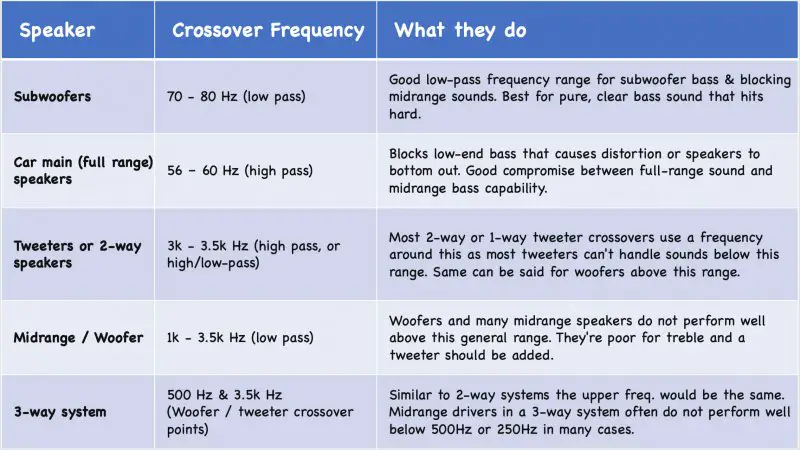
If your car stereo has an EQ, it should set the Crossover Frequency automatically, so it’s better to leave the settings alone. However, if you don’t have that or you prefer to set your own Crossover Frequency, take a look at this article for more information.
By making sure that only the right frequencies reach the right speakers, crossovers effectively reduce distortion and help improve the overall sound quality of a car audio system.
There are two types of crossover: passive crossovers and active (aka electronic crossovers). Both types essentially do the same thing, but the set-up is different.
Passive crossovers sit between the amp and the speakers, and some speakers have an inbuilt passive crossover in the speaker itself. This makes passive crossovers relatively easy to install, but they do have limitations.
Because it is filtering a signal that has already been amplified, a passive crossover wastes power, and the unwanted power is released as heat. This can affect the impedance of your speaker, which can result in inconsistent sound definition.
Active crossovers, or electronic crossovers, are a separate device and are more complex and more expensive than passive units, but they are better and give you more options for sculpting the fidelity you want.
Active crossover are wired between the head unit and amplifier so these are dealing with Line Level Signal. This helps cut out any unwanted frequencies before getting to the amp, making your amplifier much more efficient.
They also require a +12V ground connection, adding to the complexity of installation. But with a bit of patience and knowledge, anyone can install active crossovers, and they will make a huge difference to your stereo system.
The Takeaway
Understanding Car Audio Basics takes abit more research than many thinks. It’s not just about buying the biggest or the most expensive equipment, plugging it in and voila.
To get the best possible fidelity from your car audio system, you have to understand how the vital components work.
The best car stereo won’t produce mesmerising fidelity without a quality amplifier, and a subwoofer is a no-go without one, too.
Even if you’re just upgrading your car speakers, you have a fair bit of understanding to do. Do you want coaxials or components? 2-way, 3-way or even 4-way speakers? What size etcetera.
You have to consider the wiring, too. What size wiring do you need for your component? There are many factors to consider, but don’t let that put you off, because the difference an aftermarket car stereo system makes is priceless.

I am a passionate and skilled car audio enthusiast with 15 years of experience in the industry. My journey started when I replaced my first set of factory car speakers, sparking a deep love for high-quality sound. Since then, I have worked as a representative for renowned brands like Kenwood and Alpine.
With a background in both retail and distribution, I have developed a comprehensive understanding of the car audio market. Currently a certified (MECP) installer in the Mobile Electronics industry, my expertise lies in delivering top-notch audio installations. My knowledge, coupled with my genuine passion, makes me the go-to professional for all car audio needs.

